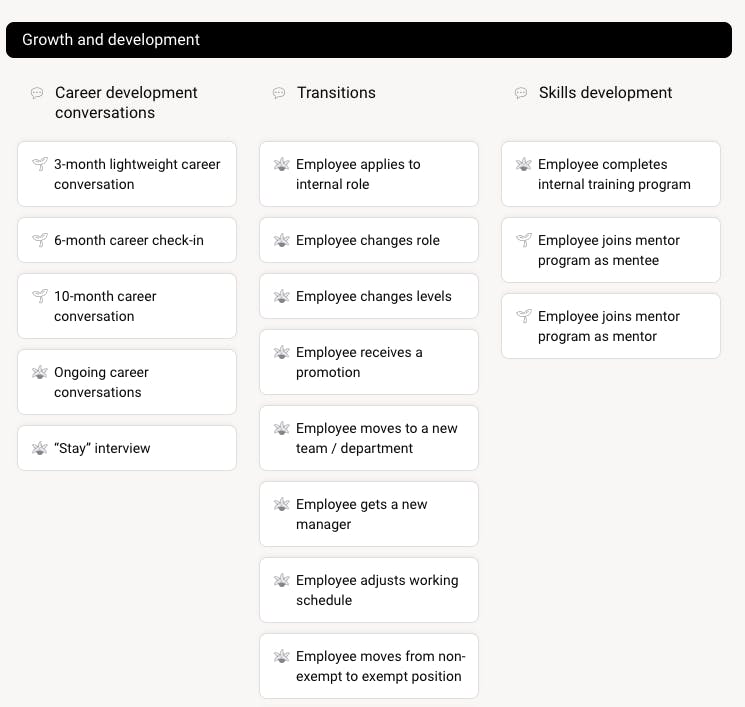
How to use your employee journey map to boost retention

Written by
Alexis (Lexi) Croswell, Customers
Beyond the cost of hiring and training an employee who leaves your company, there are hits to morale with each employee departure. Employees who may have been on the fence about staying or leaving might start their search more actively. In fact, according to research from Gallup, 51% of employees are watching for or actively seeking a new job.
Using an employee journey map helps you better retain employees by serving as a blueprint for executing on how you’ll make improvements. Companies often look for ways to boost retention from their employee survey data, or simply turn to popular methods like improving onboarding and supporting managers.
Pyn’s VP of People Strategy, Stacey Nordwall explains more, “An employee journey is all of the moments across an employee's experience at your organization from candidate through to alumni and exit. The journey map is just a visualization of that journey. So it's something that helps you to proactively design the experience and define and prioritize the work that needs to be done as part of your broader HR strategy.”
The key is how journey mapping helps you be proactive. In this case, we’ll look at how you can use your journey map to boost employee retention.
1. Identifying - and solving - pain points across the employee journey
Analyzing your employee journey map can reveal where there are gaps or pain points in the employee experience. You could start by analyzing high-impact moments that matter, like:
- Onboarding
- Manager education and support
- Life events
- Holidays and observances
- Career development
Proactively journey mapping allows you to address underlying issues in the employee experience before they lead to attrition. You can use Pyn's employee journey mapper for free. We help you get started by including an easy-to-use journey map template that you can customize.
2. Personalize employee/manager development
According to research from Culture Amp, a lack of career growth is one of the main reasons employees leave their role. Without clear strategies for development and internal mobility, employees will start to look elsewhere for growth opportunities.
Within your employee journey map, you can create personalized plans for employee and manager development. The image below shows some of the Growth and Development touchpoints included in Pyn’s Employee Journey Map template.

3. Better onboarding that makes role expectations clearer
First impressions matter, and employee onboarding is no exception. Data from BambooHR research shows that, “70% of new hires decide whether a job is the right fit within the first month—including 29% who know within the first week. On average, companies have 44 days to influence a new hire's long-term retention.”
What better way to ensure every moment of your new hire’s first days with your company are exceptional than to plan it out on your employee journey map. Pyn’s Employee Journey Map template includes touchpoints for both the candidate experience and onboarding, so you can start regular communication with new hires even before day one.
Want to take your updated onboarding one step further? Culture Amp research shows that role expectations (employees being happy with their role relative to how it was described to them) is a big factor in retention. So why not customize your employee onboarding to include details that make role expectations clear - and match what was pitched during the interview process.
4. Create a more inclusive employee experience
The third most common reason employees leave their job (again, according to our friends at Culture Amp) is inclusion. Employees who exit are less likely to feel like they belong at a company.
There are a few ways that your employee journey map can help you create a more inclusive employee experience. First, ensure that you have a diverse group of folks collaborating on your map. As DEI Consultant Natania Malin Gazek explains, rather than consulting only your “go-to” people at work, ensure you’re taking into account diverse perspectives. “The consequences of these decisions are big: the more diverse the group of stakeholders that we involve in the process of developing our EJM, the more diverse the group of employees the EJM will work for.”
Check out their article on creating an employee journey map that strengthens DEI for more.
Once your map is created, you should use it to proactively address areas of concern related to DEI. “If you see that certain departments, roles, levels of staff, or staff with specific demographic identities are sending or receiving more communications, and that those communications are causing lower turnover rates, higher performance ratings, and stronger achievement of OKRs, lift those up!” shares Natania.
5. Scheduled salary review reminders and support for managers
Competitive pay is an important tool that companies have to retain their employees. Especially when it comes to high performers, employees want to know that they are making the most for their time and effort.
By using your journey map to proactively schedule salary review reminders - for managers and employees - you can take some of the guesswork out of the process. Pyn’s employee journey map includes communication templates to help you get started, like “3 things we look at when reviewing your salary” and “How to talk with your employee about their salary review results.”
You can use Pyn’s templates as-is or customize them to fit the needs of your company. By building in this touchpoint on the employee journey, you know that you’re communicating to employees that their work is valued.

Lexi enjoys reading, hosting clothing swaps, and her dog, Tessa. She worked at Culture Amp and Torch.
